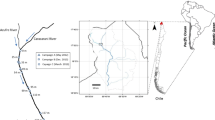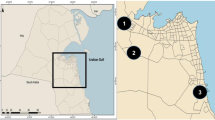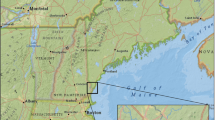Abstract
Arsenic released by bottom sediments was determined by experiments in which the sediments were artificially re-suspended using a particle entrainment simulator (PES) to simulate river conditions. Sediment cores were collected from various tributaries to drinking water reservoirs in Connecticut spiked with arsenic, and run in the PES at simulated bed-flow shear stresses from 0.0 to 0.6 N/m2. Under equilibrium conditions, the dissolved fraction of arsenic was found to range from 8.3 to 22.1 μg/l, which in most cases exceeded EPA Maximum Contaminant Level (MCL) of 10 μg/l. Experimental results from these simulations have shown that bed-flow shear stress causes an increased concentration of dissolved arsenic, most notably at shear stresses of 0.4, 0.5, and 0.6 N/m2. For the solid phase under equilibrium, the concentrations of arsenic ranged between 71 and 275 mg/kg. The average concentration of arsenic on the solid phase as well as partitioning coefficient values (K p) were highest at initial shear stress. This was attributed to the higher fraction of colloidal material and finer organic particles in the suspended solid mixture. Particles of such nature proved to have higher affinity to arsenic. K p values were determined from PES data and were found to range from 4,687 to 24,090 l/kg. However, on a mass load basis, the amount of arsenic found in suspended sediment increased with the increase of shear stress. Similarly, the amount of arsenic in the solid phase increased significantly for sites with high Volatile Organic Carbon (VOC) content. Because of the influence of Total Suspended Solids (TSS) and VOC concentrations on K p, the use of the PES is more appropriate in obtaining K p values that would be found under real stream conditions when compared to the traditional way of measuring K p using a jar study technique.
Similar content being viewed by others
References
Alkhatib, E., & Castor, K. (2000). Parameters influencing sediment resuspension and link to sorption of inorganic compounds. Environmental Monitoring and Assessment, 65, 531–546.
Alkhatib, E., & Weigand, C. (2002). Parameters affecting partitioning of 6 PCB cogeners. Environmental Monitoring and Assessment, 78, 1–17.
ATSDR (2000). Public health statement for arsenic. Atlanta, GA: Department of Health and Human Services.
AWWA (1999). Standard methods for the examination of water and wastewater. Denver, CO: American Water Works Association.
Fetter, C. W. (2002). Applied hydrology. New Jersey: Prentice Hall.
Keon, N. E., Swartz, C. H., Brabandar, D. J., Harvey, C., & Hemond, H. F. (2001). Validation of arsenic sequential extraction method for evaluating mobility in sediments. Environmental Science & Technology, 35, 2778–2885.
Lee, D. Y., Lick, W., & Kang, S. W. (1981). The entrainment and deposition of fine-grained sediments in Lake Erie. Journal of Great Lakes Research, 22, 224–233.
Mackay, D., Shiu, W. Y., & Ching, M. K. (1996). Illustrated handbook of physical chemical properties and environmental fate for organic chemicals. New York: Lewis.
Meinrat, A. (1979). Arsenic speciation in seawater and interstitial waters: The influence of biological-chemical interactions on the chemistry of a trace element. Limnology and Oceanography, 24, 440–452.
Rice, K. C., Conko, K. M., & Hornberger, G. M. (2002). Anthropogenic sources of arsenic and copper to sediments in a Suburban Lake, Northern Virginia. Environmental Science & Technology, 36, 4962–4967.
USEPA. (2005a). Arsenic compounds. Retrieved May, 2006, from http://www.epa.gov/ttn/atw/hlthef/arsenic.
USEPA. (2005b). Arsenic in drinking water. Retrieved July 10, 2006, from http://www.epa.gov/safewater/arsenic.
Author information
Authors and Affiliations
Corresponding author
Rights and permissions
About this article
Cite this article
Alkhatib, E., Berna, E. Simulation of arsenic partitioning in tributaries to drinking water resevoirs. Environ Monit Assess 137, 197–204 (2008). https://doi.org/10.1007/s10661-007-9740-0
Received:
Accepted:
Published:
Issue Date:
DOI: https://doi.org/10.1007/s10661-007-9740-0




